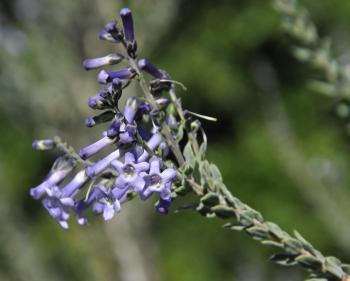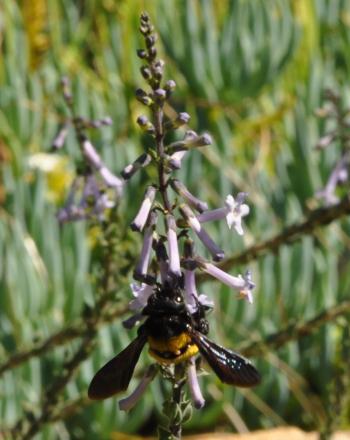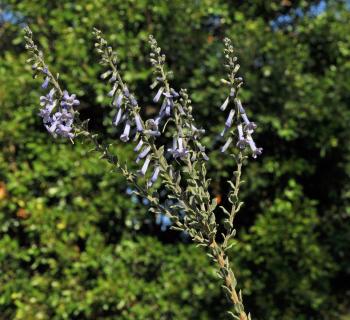Freylinia undulata
Freylinia undulata (L.f.) Benth.
Family: Scrophulariaceae
Common names: Overberg bell-bush, mauve honey-bell (Eng.); Overbergse klokkiesbos (Afr.)
Introduction
Freylinia undulata is an attractive shrub with mauve flowers, ideal for dry gardens in the winter-rainfall area.

Description
Description
Freylinia undulata is an erect, sparsely branched, woody shrub that grows to a height of 2 m. The leaves are oval, sparsely hairy with an undulating margin. It bears beautiful bell-shaped or tubular mauve flowers in lax, narrow racemes at the tips of the stems. There is also a white-flowered form. Flowering is mainly from mid-winter to mid-summer (June to December).

Conservation Status
Status
Least Concern (LC). This species has not been fully assessed but is not considered to be of conservaton concern.
Distribution and habitat
Distribution description
Freylinia undulata grows in Renosterveld and is distributed from Vanrhynsdorp in the west to Mossel Bay in the east. The habitat consists of sclerophyll shrublands and the plants occur in full sun often on rocky, shale slopes. It is the most widespread of all the freylinias.
Derivation of name and historical aspects
History
The genus was named after Count L. de Freylino, owner of a famous garden at Buttigliera near Marengo in the early 19th century. The species name undulata refers to the wavy edges of the leaf.
There are nine other species of Freylinia in South Africa, several of which including F. tropica (Waterberg bell-bush or blue freylinia) and F. lanceolata (honey bells) are attractive garden plants.

Ecology
Ecology
Freylinia undulata is hard-leaved (sclerophyllous) and adapted to a winter-rainfall climate, and capable of surviving the long summer drought typical of this region. The flowers are possibly pollinated by sunbirds and at Kirstenbosch Carpenter Bees are also observed visiting the flowers.
Uses
Use
Freylinia undulata is not known to be used for traditional medicine. Their spindly growth habit is not very appealing as a garden plant, but it is has an understated beauty and is a useful shrub for dry or water-wise gardens in the winter-rainfall area.

Growing Freylinia undulata
Grow
The plant is easily grown from cuttings. Semi-mature cuttings can be taken either in autumn or spring. A rooting hormone is used to stimulate root development. Place the cuttings in a propagation media of 50% bark and 50% polystyrene and then placed in a mist unit with under bench heating of about 24ºC, if such facilities are available. The home gardener should apply their usual techniques for taking cuttings. Plant in well-drained medium and keep damp, but not wet, in a warm spot that does not receive direct sun. The cuttings will root in about 4 weeks in the mist unit and once rooted the cuttings must be hardened-off for 3 weeks before being potted. Plant in well-drained potting soil.
Once the cuttings have been potted they will need to be placed under a shade net for 2 weeks before being exposed to the direct sunlight. A monthly feeding of an organic based fertiliser can be used to help with the growth of the plant.
This plant is suitable for mixed beds or the mixed border. It can be planted among other shrubs with similar height and growth requirements. It will benefit from regular pruning to keep it tidy and make it more bushy. Make sure the soil it is planted in is well drained and enriched with compost. Freylinia undulata must be watered well in winter and spring if grown in a summer-rainfall region.
References
- Foden, W. & Potter, L. 2005. Freylinia undulata (L.f.) Benth. National Assessment: Red List of South African Plants version 2015.1. Accessed on 2016/03/14
- Goldblatt, P. & Manning, J. 2000. Cape Plants. A conspectus of the Cape flora of South Africa. Strelitzia 9. National Botanical Institute, Pretoria & Missouri Botanical Garden, Missouri.
- Hyam, R. & Pankhurst, R. 1995. Plants and their names: a concise Dictionary. Oxford University Press Inc., New York.
- Joffe, P.1993. The gardener’s guide to South African plants. Tafelberg Publishers, Cape Town.
- Van Jaarsveld, E.J. 1991. Honeybells. Veld & Flora 77(3):90-91
- Van Jaarsveld, E.J. 1993. The genus Freylinia (Scrophulariaceae), a synoptic review. (Unpublished manuscript).
Credits
Trevor Adams & Ernst van Jaarsveld
Kirstenbosch National Botanical Garden
September 2004
updated by Alice Notten
Kirstenbosch National Botanical Garden
March 2016
Plant Attributes:
Plant Type: Shrub
SA Distribution: Eastern Cape, Western Cape
Soil type: Sandy, Loam
Flowering season: Spring, Early Summer, Winter
PH: Acid
Flower colour: Purple
Aspect: Full Sun
Gardening skill: Average
Special Features:
Horticultural zones






Rate this article
Article well written and informative
Rate this plant
Is this an interesting plant?
Login to add your Comment
Back to topNot registered yet? Click here to register.